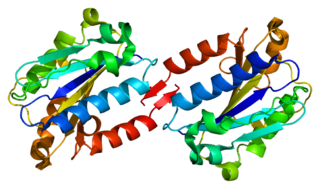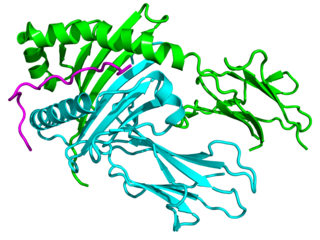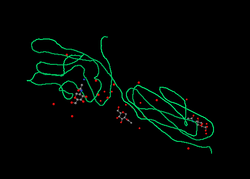
HLA class II histocompatibility antigen, DR alpha chain is a protein that in humans is encoded by the HLA-DRA gene. HLA-DRA encodes the alpha subunit of HLA-DR. Unlike the alpha chains of other Human MHC class II molecules, the alpha subunit is practically invariable. However it can pair with, in any individual, the beta chain from 3 different DR beta loci, DRB1, and two of any DRB3, DRB4, or DRB5 alleles. Thus there is the potential that any given individual can form 4 different HLA-DR isoforms.

Integrin, alpha L , also known as ITGAL, is a protein that in humans is encoded by the ITGAL gene. CD11a functions in the immune system. It is involved in cellular adhesion and costimulatory signaling. It is the target of the drug efalizumab.

CD155, also known as the poliovirus receptor, is a protein that in humans is encoded by the PVR gene. It is a transmembrane protein that is involved in forming junctions between neighboring cells. It is also the molecule that poliovirus uses to enter cells. The gene is specific to the primates.

CD49d is an integrin alpha subunit. It makes up half of the α4β1 lymphocyte homing receptor.

Leukosialin also known as sialophorin or CD43 is a transmembrane cell surface protein that in humans is encoded by the SPN (sialophorin) gene.

Major histocompatibility complex, class II, DR beta 4, also known as HLA-DRB4, is a human gene.

HLA class II histocompatibility antigen, DRB5 beta chain is a protein that in humans is encoded by the HLA-DRB5 gene.

Major histocompatibility complex, class II, DQ alpha 1, also known as HLA-DQA1, is a human gene present on short arm of chromosome 6 (6p21.3) and also denotes the genetic locus which contains this gene. The protein encoded by this gene is one of two proteins that are required to form the DQ heterodimer, a cell surface receptor essential to the function of the immune system.

HLA class II histocompatibility antigen, DP(W2) beta chain is a protein that in humans is encoded by the HLA-DPB1 gene.

HLA class II histocompatibility antigen, DRB3-1 beta chain is a protein that in humans is encoded by the HLA-DRB3 gene.

CD48 antigen also known as B-lymphocyte activation marker (BLAST-1) or signaling lymphocytic activation molecule 2 (SLAMF2) is a protein that in humans is encoded by the CD48 gene.

This gene encodes a member of the G protein-coupled receptor kinase subfamily of the Ser/Thr protein kinase family, and is most highly similar to GRK4 and GRK5. The protein phosphorylates the activated forms of G protein-coupled receptors to regulate their signaling.

CD6 is a human protein encoded by the CD6 gene.

Tyrosine-protein kinase BLK, also known as B lymphocyte kinase, is a non-receptor tyrosine kinase that in humans is encoded by the BLK gene. It is of the Src family of tyrosine kinases.

Attractin is a protein that in humans is encoded by the ATRN gene.

CD2 antigen cytoplasmic tail-binding protein 2 is a protein that in humans is encoded by the CD2BP2 gene.

HLA class II histocompatibility antigen, DX beta chain is a protein that in humans is encoded by the HLA-DQB2 gene.

CD205 also called Lymphocyte antigen 75 is a protein that in humans is encoded by the LY75 gene.

T-cell surface glycoprotein CD8 alpha chain, is a protein encoded by CD8A gene.

T-cell surface glycoprotein CD3 delta chain is a protein that in humans is encoded by the CD3D gene.

























